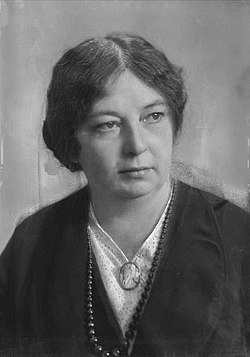Top Qs
Timeline
Chat
Perspective
1928 Nobel Prize in Literature
Award From Wikipedia, the free encyclopedia
Remove ads
The 1928 Nobel Prize in Literature was awarded to the Danish-born Norwegian novelist Sigrid Undset (1882–1949) "principally for her powerful descriptions of Northern life during the Middle Ages."[1][2] She is the third female recipient of the literature prize.
Remove ads
Laureate
Sigrid Undset's writing career started by focusing on strong, contemporary women struggling for emancipation. Inspired by her archeologist father, she later turned to writing about the Middle Ages as seen in Fortællingen om Viga-Ljot og Vigdis ("Gunnar's Daughter", 1909) and tetralogy Olav Audunssøn i Hestviken og Olav Audunssøn og Hans Børn ("The Master of Hestviken", 1925–27). Her best known work is Kristin Lavransdatter (1920–1922),

which deals with themes of honor, religious faith, and the common life shared by women and men in 15th-century Norway. According to the Swedish Academy, Undset brings to life the medieval times with solid historical knowledge, deep psychological insight, a vivid imagination, and a vigorous language. Being a convert to Catholicism, she expressed her religiosity by writing a biographical novel on St. Catherine of Siena and a hagiographical collection Sagaen om de Hellige ("Saga of Saints", 1934).[3]
Remove ads
Deliberations
Summarize
Perspective
Nominations
Sigrid Undset was only nominated in four occasions (1922, 1925, 1926, and 1928). Her last nomination which led to her being awarded the Nobel prize came from the proposal of the Norwegian psychologist Helga Eng (1875–1966).[4]
In total, the Swedish Academy received 48 nominations for 36 writers. Thirteen of the nominees were newly nominated such as Hans Driesch, Ricarda Huch, Felix Timmermans, Theodor Däubler, Armando Palacio Valdés, Rufino Blanco Fombona, Blanca de los Ríos, Anna de Noailles, and Edith Howes. The highest number of nominations (with three nomination letters each) were for the German writer Paul Ernst and the French philosopher Henri Bergson (awarded for 1927). There were six female nominees: Blanca de los Ríos, Edith Howes, Ricarda Huch, Edith Wharton, Concha Espina de la Serna, and Anna de Noailles.
The authors Ryūnosuke Akutagawa, Vicente Blasco Ibáñez, François de Curel, Robert de Flers, Brian Oswald Donn-Byrne, Edmund Gosse, Avery Hopwood, Oskar Jerschke, Henry Festing Jones, Juan Bautista Justo, Ladislav Klíma, Charlotte Mew, Barry Pain, Frank Ramsey, George Ranetti, José Eustasio Rivera, Max Scheler, Aron Hector Schmitz (known as Italo Svevo), Antonín Sova, Sir George Trevelyan, Paul van Ostaijen, Stanley John Weyman, and Elinor Wylie died without having been nominated for the prize.
Remove ads
Prize decision
The main contenders for the 1928 Nobel Prize in Literature were Thomas Mann, the Russian author Maxim Gorky and Sigrid Undset. The members of the Nobel committee were divided between the candidates. Committee chairman Per Hallström pushed for a prize to Thomas Mann, but failed to gain support for the proposal. Committee member Anders Österling supported Gorky's candidacy, while other committee members dismissed Gorky for his "raw" and "brutal" writing. Member Henrik Schück was negative towards all three candidates for estetical reasons. Ultimately Undset was the chosen winner, mainly because of the Nobel committee's appreciation of her novel trilogy Kristin Lavransdatter. Thomas Mann was subsequently awarded the 1929 Nobel Prize in Literature.[5][6]
Award ceremony

At the award ceremony in Stockholm on 10 December 1928, Per Hallström of the Swedish Academy said:
Sigrid Undset has received the Nobel Prize in Literature while still in her prime, an homage rendered to a poetic genius whose roots must be in a great and well-ordered spirit.[7]
Notes
- Georg Bonne's nominations were made by professors from Kiel, Halle (Saale), Freiburg im Breisgau, and others.
- Paul Ernst was nominated by E. Ermatinger and R. Faesi, both professors of German literature at the University of Zurich
- Armando Palacio Valdés was nominated by approximately 20 members of the Royal Spanish Academy, and also by a number of professors at Spanish universities.
Remove ads
References
External links
Wikiwand - on
Seamless Wikipedia browsing. On steroids.
Remove ads

